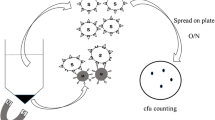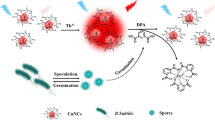Abstract
A novel assay was developed for the detection of Bacillus thuringiensis (BT) spores. The assay is based on the fluorescence observed after binding an aptamer-quantum dot conjugate to BT spores. The in vitro selection and amplification technique called SELEX (Systematic Evolution of Ligands by EXponential enrichment) was used in order to identify the DNA aptamer sequence specific for BT. The 60 base aptamer was then coupled to fluorescent zinc sulfide-capped, cadmium selenide quantum dots (QD). The assay is semi-quantitative, specific and can detect BT at concentrations of about 1,000 colony forming units/ml.






Similar content being viewed by others
References
Alivisatos AP (1996) Semiconductor clusters, nanocrystals, and quantum dots. Science 271:933–937
Chan WCW, Maxwell DJ, Gao X, Bailey RE, Han M, Nie S (2002) Luminescent quantum dots for multiplexed biological detection and imaging. Curr Opin Biotechnol 13:40–46
Lidke DS, Arndt-Jovin DJ (2004) Imaging takes a quantum leap. Physiology 19:322–324
Nirmal M, Brus LE (1999) Luminescence photophysics in semiconductor nanocrystals. Acc Chem Res 32:407–414
Bruches M, Moronne M, Gin P, Weiss S, Alivisatos AP (1998) Semi- conductor nanocrystals as fluorescent biological labels. Science 281:2013–2016
Chan WCW, Nie S (1998) Quantum dot bioconjugates for ultrasensitive nonisotopic detection. Science 281:2016–2018
Han M, Gao X, Su JZ, Nie S (2001) Quantum-dot-tagged microbeads for multiplexed optical coding of biomolecules. Nat Biotechnol 19:631–635
Rosenthal SJ (2001) Bar coding biomolecules with fluorescent nanocrystals. Nat Biotechnol 19:621–622
Hoile R, Yuen M, James G, Gilbert GL (2006) Evaluation of the rapid analyte measurement platform (RAMP) for the detection of Bacillus anthracis at a crime scene. Forensic Sci Int, Oct 16
Tuerk C, Gold L (1990) Systemic evolution of ligands by exponential enrichment: RNA ligands to bacteriophage T4 DNA polymerase. Science 249:505–510
Ellington AD, Szostak JW (1990) In vitro selection of RNA molecules that bind specific ligands. Nature 346:818–822
Brody NE, Gold L (2000) Aptamers as therapeutic and diagnostic agents. Rev Mol Biotechnol 74:5–13
Nutiu R, Yingfu L (2003) Structure-switching signaling aptamers. J Am Chem Soc 125:4771–4778
Proske D, Blank M, Buhmann R, Resch A (2005) Aptamers-basic research, drug development, and clinical applications. Appl Microbiol Biotechnol 69:367–374
Rimmele M (2003) Nucleic acid aptamers as tools and drugs. Chem Bio Chem 4:963–971
Dwarakanath S, Bruno JG, Shastry A, Phillips T, John A, Kumar A, Stephenson LD (2004) Quantum dot-antibody and aptamer conjugates shift fluorescence upon binding bacteria. Biochem Biophys Res Comm 325:739–743
Kloepfer JA, Mielke RE, Wong MS, Nealson KH, Stucky G, Nadeau JL (2003) Quantum dots as strain- and metabolism-specific microbiological labels. Appl Environ Microbiol 69:4205–4213
Bruno JG, Kiel JL (1999) In vitro selection of DNA aptamers to anthrax spores with electrochemiluminescence detection. Biosensors Bioelectronics 14:457–464
Jayasena SD (1999) Aptamers: an emerging class of molecules that rival antibodies in diagnostics. Clin Chem 45:1628–1650
Drobniewski FA (1994) A review: the safety of Bacillus species as insect control agents. J Appl Bacteriol 76:101–109
Helgason E, Okstad O, Caugant D, et al. (2000) Bacillus anthracis, Bacillus cereus and Bacillus thuringiensis-one species on the basis of genetic evidence. Appl Environ Microbiol 66:2627–2630
Lambert B, Peferoen M (1992) Insecticidal promise of Bt. BioScience 42:112–122
Ruud A, Bravo A, Crickmore N (2001) How Bacillus thuringiensis has evolved specific toxins to colonize the insect world. Trends Genetics 17:193–199
Bruno JG, Ulvick SJ, Uzzell GL, Tabb JS, Valdes ER, Batt CA (2001) Novel immuno-FRET assay method for Bacillus spores and E. coli O157:H7. Biochem Biophys Res Comm 287:875–880
Bennet RW, Harmon SM (1990) Bacillus cereus food poisoning. Laboratory diagnosis of infectious disesases: principles and practice. Vol. 1: Bacterial, mycotic and parasitic diseases. Springer-Verlag, New York.
Siegel JP (2001). The mammalian safety of Bacillus thuringiensis-based insecticides. J Invertebrate Pathol 77:13–21
Swadener C (1994) Bacillus thuringiensis. J Pesticide Reform 14:13–20
Bruno JG, Kiel JL (2002) Use of magnetic beads in selection and detection of biotoxin aptamers by ECL and enzymatic methods. BioTechniques 32:178–183
Sheng Z, Brooks A, Carlson K, Filner P (1989) Separation of protein crystals from spores of Bacillus thuringiensis by Ludox gradient centrifugation. Appl Environ Microbiol 55:1279–1281
Zhao X, Hilliard LR, Mechery SJ, Wang Y, Bagwe RP, Jin S, Tan W (2004) A rapid bioassay for single bacterial cell quantitation using bioconjugated nanoparticles. Proc Nat Acad Sci 101:15027–15032
Mann D, Reinemann C, Stoltenburg R, Strehlitz B (2005) In vitro selection of DNA aptamers binding ethanolamine. Biochem Biophys Res Comm 338:1928–1934
Acknowledgements
The authors thank the U.S. Air Force Research Laboratory, Brooks City-Base, San Antonio, TX, for partial laboratory support. We would also like to acknowledge the Department of Defense (U.S. Army Contract No. DACA42-03-C-0063) for financial support of this project.
Author information
Authors and Affiliations
Corresponding author
Rights and permissions
About this article
Cite this article
Ikanovic, M., Rudzinski, W.E., Bruno, J.G. et al. Fluorescence Assay Based on Aptamer-Quantum Dot Binding to Bacillus thuringiensis Spores. J Fluoresc 17, 193–199 (2007). https://doi.org/10.1007/s10895-007-0158-4
Received:
Accepted:
Published:
Issue Date:
DOI: https://doi.org/10.1007/s10895-007-0158-4




